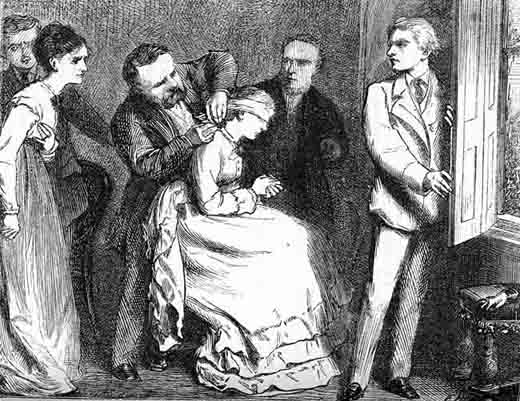Dear Serial Readers,
Are you finding it difficult to keep up, to keep going, with this serial novel? I ask because several people indicated their intention to join the serial blogging this time, but unless you post here, I don't know who is reading along. Please do comment, even if you're not finding a way to keep going along with the installments. Kari found the novel rough to enter into, but more engaging later on--so don't be deterred by the Proem and first chapters, and the piles of scholarly allusions.
Julia mentioned last time the tension between inner life and external appearances of characters; this difference made me think of the narrator's occasional remarks about Florence "then" (within the narrative time frame) and "now" (the temporality of narration, presumably around 1862). I also see Kari's point--that there isn't much focus on Romola early on to warrant the title of the novel. This contrast of attention reminds me of the first books of Daniel Deronda which readers have thought might well have been titled "Gwendolen Harleth" instead. So maybe Eliot likes to warm up to her entitled characters--although I'm not sure that's the case with her other male-titled novels, Adam Bede, Silas Marner, Felix Holt. But if you are interested in Romola, be assured that you'll see much much more of her as the novel progresses!
Still, "Tito Melema" might seem a better title for these early segments. I'm finding this character a bit perplexing as a (early) modern villain in that he's difficult to dismiss as totally terrible; yes, his external appearances and manners are alluring, especially to young women, but we know he's ethically challenged. But again, Eliot's psychological realism plays with such complexities. In any case, thanks to Tito's multiple attractions, there seems to be a bigamy marriage plot unfolding, much like the "bigamy novels" of sensation writers like Mary E. Braddon.
Julia also mentions the suspense around Fra Luca that closes the second installment. This time, we have the mounting suspense around Fra Luca (aka Dino) revealing Tito's betrayal to Romola as well as Tito's feigned marriage to Tessa--presumably another transgression to be revealed to Romola at some point.
Next time, installment four--chapters 15-20. I hope to hear from more of you Serial Readers lurking out there! Even a sentence or fragment of a comment is welcome!
Serially yours,
Susan

3 comments:
I'm behind. I just posted for chapter 6-10.
I am intrigued by Tito and the extent to which he is a villain. I like the way he is eased into further acts of selfishness, and the way he tries to assuage his conscience early on and as time progresses he spends less and less time guilty--what matters is whether his acts are revealed, so, indeed, his public face.
I am curious to see what his trajectory will be: will it be consistently downward into villainy? Right now it seems that way, and I find that a little disappointing as a narrative structure. But I'll see!
I was delighted to meet Monna Brigida. I loved the description of the labor that went into her clothing, designed merely to display that laborers had to be employed! And I was expecting an uptight snob and then she turns out to be so delightfully chatty and interested in earthly delights.
I find Tito's "marriage" to Tessa so disturbing, especially so because Tito has no compunctions here at all--he just knows that if he tells her it was not marriage, he'll "spoil" her innocence. Of course, when she finds out they are not married, as she someday must, her innocence will be lost, but he will no longer be needing the comfort of that "pretty trustfulness."
I enjoyed this section and am looking forward to the next!
I realize it's Thursday and we are probably moving on to discuss the next section shortly, but I wanted to point out my favorite passage from this section before we leave Tessa alone for awhile! When Eliot's narrator is laying out the scene in which Tito finds Tessa in the Nunziata (ch. 14), she describes "the crowd of votive waxen images" with "faces blackened and robes tattered by the corroding breath of centuries, others fresh and bring in new mantle or steel corselet, the exact doubles of the living.... wedged in with all of these were detached arms, legs, and other members.... It was a perfect resurrection-swarm of remote mortals and fragments of mortals, reflecting, in their varying degrees of freshness, the somber dinginess and sprinkled brightness of the crowd below."
I love the dreamlike/eerie tone that the description of the fragments lends to the scene; the way the older, corroded ones both mark the passage of history for the viewer and are also juxtaposed against the new, almost "present" votives seems to call for a strange (maybe paradoxical) collapse of temporal dimensions via the visual image of time passing. Time is alive, but has a "corroding breath" that will eventually render all the votives fragments: the reader must acknowledge, especially since the newer votives are the "doubles" of the living and that both old and new are "reflecting" the crowd below, that our own present moment is not separate from what we count as past, (what the Florentines historicized by putting up on the wall), but is rather hazily blurred with the history. I think this theme is outlined in the Proem and elaborated on generally within the main text, but what are we to make of this description of fragments as a set-up to Tito finding Tessa? Does it inform in any way the reader's reading of Tito's character/his relationship with Tessa as an example of his character? Or does it just serve to create an atmospheric haziness appropriate for the worshippers' environment?
Post a Comment